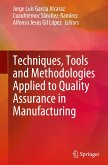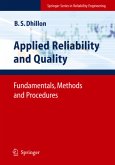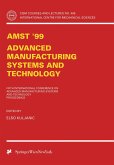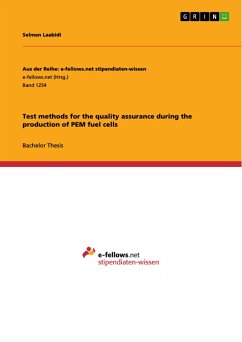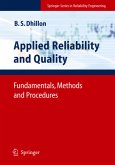- Broschiertes Buch
- Merkliste
- Auf die Merkliste
- Bewerten Bewerten
- Teilen
- Produkt teilen
- Produkterinnerung
- Produkterinnerung
It is in general not possible to produce technical products having precisely predefined measures. Systematic and random deviations from nominal size cannot be avoided, and it is therefore necessary to define measurement tolerances. This book offers a comprehensive presentation of tolerance problems and their solution by statistical methods. All calculated solutions are presented in clear figure or graphical form. It is particularly appropriate for those working in the field of development and construction or in production and quality control, especially in mechanical engineering and related fields.…mehr
Andere Kunden interessierten sich auch für
![Techniques, Tools and Methodologies Applied to Quality Assurance in Manufacturing Techniques, Tools and Methodologies Applied to Quality Assurance in Manufacturing]() Techniques, Tools and Methodologies Applied to Quality Assurance in Manufacturing121,99 €
Techniques, Tools and Methodologies Applied to Quality Assurance in Manufacturing121,99 €![Techniques, Tools and Methodologies Applied to Quality Assurance in Manufacturing Techniques, Tools and Methodologies Applied to Quality Assurance in Manufacturing]() Techniques, Tools and Methodologies Applied to Quality Assurance in Manufacturing89,99 €
Techniques, Tools and Methodologies Applied to Quality Assurance in Manufacturing89,99 €![Applied Reliability and Quality Applied Reliability and Quality]() Balbir S. DhillonApplied Reliability and Quality113,99 €
Balbir S. DhillonApplied Reliability and Quality113,99 €![AMST'99 - Advanced Manufacturing Systems and Technology AMST'99 - Advanced Manufacturing Systems and Technology]() Elso Kuljanic (ed.)AMST'99 - Advanced Manufacturing Systems and Technology121,99 €
Elso Kuljanic (ed.)AMST'99 - Advanced Manufacturing Systems and Technology121,99 €![Test methods for the quality assurance during the production of PEM fuel cells Test methods for the quality assurance during the production of PEM fuel cells]() Selmen LaabidiTest methods for the quality assurance during the production of PEM fuel cells39,99 €
Selmen LaabidiTest methods for the quality assurance during the production of PEM fuel cells39,99 €![Control Charts and Machine Learning for Anomaly Detection in Manufacturing Control Charts and Machine Learning for Anomaly Detection in Manufacturing]() Control Charts and Machine Learning for Anomaly Detection in Manufacturing129,99 €
Control Charts and Machine Learning for Anomaly Detection in Manufacturing129,99 €![Applied Reliability and Quality Applied Reliability and Quality]() Balbir S. DhillonApplied Reliability and Quality121,99 €
Balbir S. DhillonApplied Reliability and Quality121,99 €-
-
-
It is in general not possible to produce technical products having precisely predefined measures. Systematic and random deviations from nominal size cannot be avoided, and it is therefore necessary to define measurement tolerances. This book offers a comprehensive presentation of tolerance problems and their solution by statistical methods. All calculated solutions are presented in clear figure or graphical form. It is particularly appropriate for those working in the field of development and construction or in production and quality control, especially in mechanical engineering and related fields.
Hinweis: Dieser Artikel kann nur an eine deutsche Lieferadresse ausgeliefert werden.
Hinweis: Dieser Artikel kann nur an eine deutsche Lieferadresse ausgeliefert werden.
Produktdetails
- Produktdetails
- Verlag: Springer, Berlin
- Softcover reprint of the original 1st ed. 1991
- Seitenzahl: 348
- Erscheinungstermin: 19. Mai 2012
- Englisch
- Abmessung: 235mm x 155mm x 19mm
- Gewicht: 528g
- ISBN-13: 9783642486913
- ISBN-10: 3642486916
- Artikelnr.: 37477983
- Herstellerkennzeichnung
- Books on Demand GmbH
- In de Tarpen 42
- 22848 Norderstedt
- info@bod.de
- 040 53433511
- Verlag: Springer, Berlin
- Softcover reprint of the original 1st ed. 1991
- Seitenzahl: 348
- Erscheinungstermin: 19. Mai 2012
- Englisch
- Abmessung: 235mm x 155mm x 19mm
- Gewicht: 528g
- ISBN-13: 9783642486913
- ISBN-10: 3642486916
- Artikelnr.: 37477983
- Herstellerkennzeichnung
- Books on Demand GmbH
- In de Tarpen 42
- 22848 Norderstedt
- info@bod.de
- 040 53433511
1 Introduction.- 2 Concepts.- 3 Probability Calculation.- 3.1 Definition of Probability.- 3.2 Addition Formula (OR Formula).- 3.3 Multiplication Formula (AND Formula).- 4 Probability Distributions of Quantitative Characteristics.- 4.1 General.- 4.2 Normal Distribution.- 4.3 Abnormal Probability Distributions.- 4.4 Random Spread for Mean Values.- 5 Mathematical and Graphical Evaluation of Dimensional Series.- 5.1 General.- 5.2 Mathematical Evaluation Without Classification.- 5.3 Graphical Evaluation Without Classification.- 5.4 Mathematical Evaluation of Classified Dimensional Series.- 5.5 Graphical Evaluation of Classified Dimensional Series.- 5.6 Other Statistical Characteristics.- 5.7 The Significance of Statistical Characteristics.- 6 Mixed Distributions.- 6.1 Types of Mixed Distribution.- 6.2 Mixed Distribution Type 1.- 6.3 Mixed Distribution Type 2.- 6.4 Tschebyscheff's Extreme Case.- 7 Distribution Folds.- 7.1 Description of Fold Methods.- 7.2 Examples of Folding Methods.- 8 Relationship Between Tolerances and Production Distributions.- 8.1 Direct and Indirect Function Characteristics.- 8.2 Establishment and Observance Tolerances.- 8.3 Tolerances and Costs.- 8.4 Errors and Waste.- 8.5 Arithmetical Tolerance Calculation.- 8.6 Examples for Arithmetically Calculated Linear Dimensional Chains.- 8.7 The Sorting of Non-Conforming Parts.- 9 Tolerance Calculation Using Square Law.- 10 Statistical Calculation of Tolerances of Individual Values with Rectangular Distributions.- 10.1 General.- 10.2 Derivation of Reduction and Expansion Factors with Equal Individual Tolerances.- 10.3 Calculation of Dimensional Chains with Unequal Individual Tolerances and Rectangular Individual Distributions.- 10.4 Advantages of the Assumption of the Presence of Rectangular Distributions.-11 Statistical Tolerance Calculation of Individual Values with Trapezoid Distribution or with Triangular Distribution.- 11.1 Method of Calculation.- 11.2 Simple Formula to Check Fixed Linear Dimensional Chains.- 12 The Tolerance Model.- 13 Assessment of Completed Batches and Production Batches.- 13.1 General.- 13.2 Random Sample Dimension Tests.- 13.3 Selection of AQL Values for Random Sample Tests of Dimensions (Variable Testing).- 13.4 Quality Control Charts for Dimensions.- 14 Process Analysis and Process Capability.- 14.1 Process Analysis.- 14.2 Process Capability.- 15 Process Control.- 15.1 General Aspects.- 15.2 Process Control by Mean Value Quality Control Charts.- 15.3 Process Control by Original Value QCC's.- 15.4 Process Correction.- 16 Bibliography.- 17 Appendix.- Tables.
1 Introduction.- 2 Concepts.- 3 Probability Calculation.- 3.1 Definition of Probability.- 3.2 Addition Formula (OR Formula).- 3.3 Multiplication Formula (AND Formula).- 4 Probability Distributions of Quantitative Characteristics.- 4.1 General.- 4.2 Normal Distribution.- 4.3 Abnormal Probability Distributions.- 4.4 Random Spread for Mean Values.- 5 Mathematical and Graphical Evaluation of Dimensional Series.- 5.1 General.- 5.2 Mathematical Evaluation Without Classification.- 5.3 Graphical Evaluation Without Classification.- 5.4 Mathematical Evaluation of Classified Dimensional Series.- 5.5 Graphical Evaluation of Classified Dimensional Series.- 5.6 Other Statistical Characteristics.- 5.7 The Significance of Statistical Characteristics.- 6 Mixed Distributions.- 6.1 Types of Mixed Distribution.- 6.2 Mixed Distribution Type 1.- 6.3 Mixed Distribution Type 2.- 6.4 Tschebyscheff's Extreme Case.- 7 Distribution Folds.- 7.1 Description of Fold Methods.- 7.2 Examples of Folding Methods.- 8 Relationship Between Tolerances and Production Distributions.- 8.1 Direct and Indirect Function Characteristics.- 8.2 Establishment and Observance Tolerances.- 8.3 Tolerances and Costs.- 8.4 Errors and Waste.- 8.5 Arithmetical Tolerance Calculation.- 8.6 Examples for Arithmetically Calculated Linear Dimensional Chains.- 8.7 The Sorting of Non-Conforming Parts.- 9 Tolerance Calculation Using Square Law.- 10 Statistical Calculation of Tolerances of Individual Values with Rectangular Distributions.- 10.1 General.- 10.2 Derivation of Reduction and Expansion Factors with Equal Individual Tolerances.- 10.3 Calculation of Dimensional Chains with Unequal Individual Tolerances and Rectangular Individual Distributions.- 10.4 Advantages of the Assumption of the Presence of Rectangular Distributions.-11 Statistical Tolerance Calculation of Individual Values with Trapezoid Distribution or with Triangular Distribution.- 11.1 Method of Calculation.- 11.2 Simple Formula to Check Fixed Linear Dimensional Chains.- 12 The Tolerance Model.- 13 Assessment of Completed Batches and Production Batches.- 13.1 General.- 13.2 Random Sample Dimension Tests.- 13.3 Selection of AQL Values for Random Sample Tests of Dimensions (Variable Testing).- 13.4 Quality Control Charts for Dimensions.- 14 Process Analysis and Process Capability.- 14.1 Process Analysis.- 14.2 Process Capability.- 15 Process Control.- 15.1 General Aspects.- 15.2 Process Control by Mean Value Quality Control Charts.- 15.3 Process Control by Original Value QCC's.- 15.4 Process Correction.- 16 Bibliography.- 17 Appendix.- Tables.


